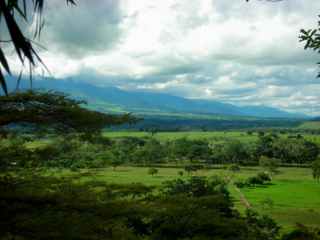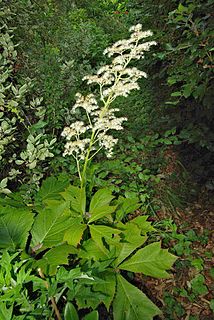
A sporangium is an enclosure in which spores are formed. It can be composed of a single cell or can be multicellular. All plants, fungi, and many other lineages form sporangia at some point in their life cycle. Sporangia can produce spores by mitosis, but in nearly all land plants and many fungi, sporangia are the site of meiosis and produce genetically distinct haploid spores.

Ceiba is a genus of trees in the family Malvaceae, native to tropical and subtropical areas of the Americas and tropical West Africa. Some species can grow to 70 m (230 ft) tall or more, with a straight, largely branchless trunk that culminates in a huge, spreading canopy, and buttress roots that can be taller than a grown person. The best-known, and most widely cultivated, species is Kapok, Ceiba pentandra, one of several trees called kapok.

Marattiaceae is the only family of extant (living) ferns in the order Marattiales. In the Pteridophyte Phylogeny Group classification of 2016, Marattiales is the only order in the subclass Marattiidae. The family has six genera and about 110 species. Many are different in appearance from other ferns, having large fronds and fleshy rootstocks.

Dioscorea is a genus of over 600 species of flowering plants in the family Dioscoreaceae, native throughout the tropical and warm temperate regions of the world. The vast majority of the species are tropical, with only a few species extending into temperate climates. It is named by the monk Charles Plumier after the ancient Greek physician and botanist Dioscorides.

Bombax is a genus of mainly tropical trees in the mallow family. They are native to western Africa, the Indian subcontinent, Southeast Asia, and the subtropical regions of East Asia and northern Australia. It is distinguished from the genus Ceiba, which has whiter flowers.

The Llanos is a vast tropical grassland plain situated to the east of the Andes in Colombia and Venezuela, in northwestern South America. It is an ecoregion of the tropical and subtropical grasslands, savannas, and shrublands biome.

Manihot is a genus in the diverse milkspurge family, Euphorbiaceae. It was described as a genus in 1754.

Enchytraeidae is a family of microdrile oligochaetes. They resemble small earthworms and include both terrestrial species known as potworms that live in highly organic terrestrial environments, as well as some that are marine. The peculiar genus Mesenchytraeus is known as "ice worms", as they live in glaciers and will die if exposed to temperatures a few degrees above freezing. Apart from these, the best-known species is probably the Grindal Worm, which is commercially bred as aquarium fish food.
Christensenia is a genus of ferns in the botanical family Marattiaceae. The genus is confined to the Indo-Malayan region. The basal chromosome number for this genus is 2n=80.

Iriartea is a genus in the palm family Arecaceae, native to Central and South America. The best-known species – and probably the only one – is Iriartea deltoidea, which is found from Nicaragua, south into Bolivia and a great portion of Western Amazonian basin. It is the most common tree in many forests in which it occurs. It is known by such names as bombona or cacho de vaca. In the Murui Huitoto language of southwestern Colombia, it is called jɨagɨna or jɨaìgɨna, in western Ecuador it is known as pambil and in Peru it is known as the pona palm.

Rodgersia is a genus of flowering plants in the Saxifragaceae family. Rodgersia are herbaceous perennials originating from east Asia.

Eusporangiate ferns are vascular spore plants, whose sporangia arise from several epidermal cells and not from a single cell as in leptosporangiate ferns. Typically these ferns have reduced root systems and sporangia that produce large amounts of spores

Van Hall Larenstein, University of Applied Sciences, often abbreviated as VHL, is a vocational university in the Netherlands. It has locations in Leeuwarden and Velp.
Ectemnorhinini is a weevil tribe in the subfamily Entiminae.

7,8-Dihydroxyflavone is a naturally occurring flavone found in Godmania aesculifolia, Tridax procumbens, and primula tree leaves. It has been found to act as a potent and selective small-molecule agonist of the tropomyosin receptor kinase B (TrkB), the main signaling receptor of the neurotrophin brain-derived neurotrophic factor (BDNF). 7,8-DHF is both orally bioavailable and able to penetrate the blood–brain barrier. A prodrug of 7,8-DHF with greatly improved potency and pharmacokinetics, R13, is under development for the treatment of Alzheimer's disease.
Godmaniais a genus of five species of flowering plants in the family Bignoniaceae, native to the new world tropics.
Godmania aesculifolia is a species of tree in the family Bignoniaceae, native to the New World tropics.

The La Costa xeric shrublands (NT1309) is an ecoregion in Venezuela that stretches along the Caribbean coast. The dry scrub and savanna has been subject to modification since the 16th century by European colonists who replaced it by a patchwork of farm fields and pasturage. Little of the original habitat remains.
Dioscorea aesculifolia is a herbaceous vine in the genus Dioscorea. The type specimen was collected in Brazil in 1994. The type specimen is damaged, but it appears to have palmate leaves with leaflets arranged in groups of five – a feature which is in contrast to the simple leaves of most well-known species of the genus Dioscorea.

The Southern Pacific dry forests is a tropical dry broadleaf forest ecoregion in southern Mexico.














